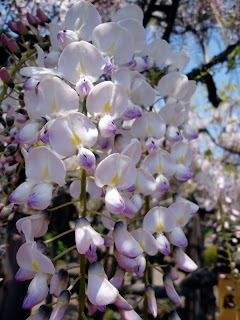Azalea, wisteria, phlox...
Just before Golden Week (late April), a whole host of flowers burst into full bloom, sparking a frenzy of flower viewing. I travelled to Tatebayashi in Gunma prefecture, to see "shibazakura" - phlox, and "tsutsuji" - azaleas. Closer to home, Nezu shrine has a spectacular tsutsuji matsuri, Kameido shrine is famous for "fuji" - wisteria, and my old favourite, Horikiri Shobuen (most famous for its irises in late June/July) also has gorgeous wisteria and peonies.
In Tatebayashi, the newly revamped "The Treasures Garden" has carpets of pale pink, magenta and blue shibazakura, plus an English-style walled garden. It's a lovely place to walk around and they have THE BEST sakura flavour icecream! You can also buy potted plants to take home and honey made from local flowers.
 |
| Shibazakura at The Treasures Garden |
 |
| That's the real colour - no enhancement needed! |
 |
| There's also a "viburnum walk" |
Getting there: we drove - it's about 30 mins from Omiya on the expressway. You can take a train to Tatebayashi station, then a taxi (about 10 mins) or you can walk from Morinji Station (about 15 minutes). Entrance fee is around 500 yen for adults.
Then we headed over to the famous azalea park, Tsutsujigaoka park, about 10 minutes drive away. It is VERY popular at the peak of azalea season, which falls at the beginning of Golden Week. Bus loads of old ladies were disgorging into the souvenir shops and tour groups were traipsing through the hills of flowers. It is spectacular, though: over 10,000 azalea trees - they're too big to be bushes - some of them are over 800 years old. I was also impressed that the toilet facilities were clean and new and had real, fresh flowers! There are lots of casual snack places to enjoy a beer and some yakitori or dango.
 |
| Flowers, as far as the eye can see |
 |
| You can also take a mini river cruise, but it only goes in a circle. |
 |
| Some of the older trees |
 |
| Yay! Camera Ojisan! |
Getting there:You can take a taxi or bus from Tatebayashi station. It's about an hour and a half by train from Tokyo on the Tobu Isesaki line. Entrance fee is around 300 yen at the beginning and end of the azalea season, and 600 yen at the peak.
Closer to home, I love Nezu Jinja any time of year (there are some great taiyaki shops nearby and you must try the karinto - sweet, fried cookies!). The Tsutsuji Matsuri starts about a week before Golden Week and there are lots of stalls selling yakisoba, takoyaki and grilled corn. A lot of women dress up in their spring kimono, which look lovely contrasted with the bright pink hills. It costs about 200 yen to enter the garden, but you can also just see it from the shrine grounds, for free.
 |
| Nezu shrine with red torii gates and a hill of azaleas with meandering paths, is lovely. |
The image of wisteria flowers growing over a trellis is a classic in Japanese traditional art, and the most celebrated place to see it is Kameido Tenjin shrine (see my post about Kameido, here:
http://minimeibutsu.blogspot.jp/2012/05/kameido.html) But for my money, the best place to go is Horikiri Shobuen, in Katsushika ward. It's just 15 minutes from Ueno on the Keisei line (ok, I'm biased - I used to live 5 mins walk from the park). For one thing, it's free, and on a weekday, you'll have the place almost to yourself. Grab a few onigiri from the shop near Horikiri station and enjoy your lunch sitting under the wisteria.
 |
| Wisteria at Horikiri Shobuen, a 10 minute walk from Horikiri station. |





































